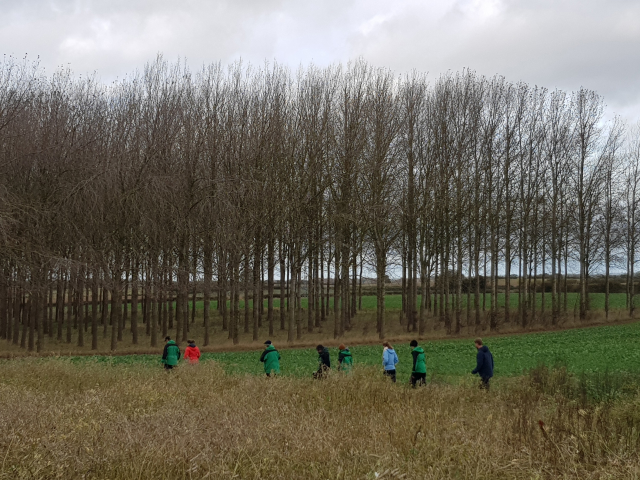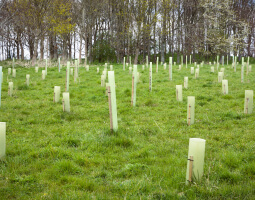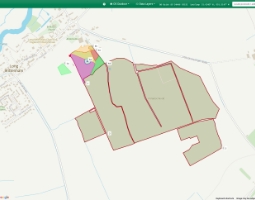Agroforestry
Agroforestry is a name given to land management systems involving agriculture and trees. Agroforestry includes both ‘trees between fields’, such as hedgerows and shelterbelts, ‘trees in fields’, such as trees mixed with livestock (silvopasture) or crops (silvoarable), and ‘farm woodland’.
Agroforestry systems currently occupy 3.3% of UK agricultural area, compared to the estimated wider European average of 8.8% (Agriculture, Ecosystems & Environment, 2017). There is interest in increasing the planting of trees on farmland as it can bring both environmental and economic benefits to farms and could increase land-based carbon sequestration in the UK and contribute towards net zero targets.

Agroforestry Systems
Agroforestry can be classified into three main types (Burgess et al., 2022):
Trees in fields: these comprise silvopastoral or silvoarable systems.
Silvopastoral systems closely integrate trees and livestock on the same land, and include grazed land where trees are planted at lower densities than woodland or woodland that has been opened up to allow animals to graze. Silvopastoral systems can include wood pasture, parkland and meadow orchards.
Silvoarable agroforestry involves trees integrated with annual or perennial crops, with the trees typically planted in rows at wide spacing (e.g. 30 m) to allow light to reach crops and machinery access between rows.
Trees between fields: where trees are used to demarcate a boundary and/or provide shelter, such as hedgerows, shelterbelts and trees along ditches or streams.
Farm woodland: woodland on farms under a wide range of management types, including traditional forests (e.g. shelterbelts), short rotation forestry, coppice, or non-timber food woodland providing fruits and nuts. These may be combined with some livestock grazing once established.
Over time, the system may change, for example, transitioning from silvoarable to silvopastoral systems, or farm woodland to silvopasture.
Benefits of Agroforestry
Farming benefits
While adding trees to farmland will take up some land that would otherwise be cropped or grassed, agroforestry has many benefits. Silvopastoral systems can improve livestock welfare and growth, as trees provide shelter which can help buffer against adverse weather, such as summer heatwaves, frosts and strong winds. Trees and hedgerows can provide comfort to browsing livestock as well as additional food sources to provide a more diverse diet.
Trees in arable systems can provide crops with protection from wind, and can also maintain a more humid environment and reduce crop evaporation losses, and provide shade from summer heat.
Environmental benefits
Adding trees to farms generally increases biodiversity, particularly for invertebrates and birds. Trees can provide food sources and shelter. Hedgerows can provide valuable habitat connectivity, including corridors for wildlife connecting patches of woodland habitat. Trees can support pollinating species, natural pest enemies and increase soil fauna diversity, but may encourage some weed and pest species. Mature trees in parkland systems can also provide important habitats for specialist species.
Trees can aid soil retention and improve water-course quality on farms by reducing runoff and waterway pollution as well as reducing waterlogging and flooding. Trees can also help reduce soil erosion from wind and rain.
Carbon benefits
Agroforestry can enhance carbon stocks on agricultural land and so could help to increase carbon sequestration and carbon storage in the agricultural sector.
The amount of carbon sequestered depends upon the agroforestry system, tree planting density, tree species, tree age, soil type, site management and climate. In general, of the various agroforestry options, systems with greater densities of trees (e.g. farm woodlands), and those with larger, taller trees (e.g. shelterbelts) will sequester the most carbon. Systems with lower tree densities (e.g. silvoarable) or smaller trees (e.g. managed hedgerows, orchards) will sequester less carbon.
The impact of tree planting on soil carbon stocks can be variable, depending on the initial soil carbon stocks (influenced by the previous land use and soil type) and the level of soil disturbance at tree planting. Converting permanent grassland, where carbon stocks can be high, to agroforestry may have little effect on soil carbon stocks if few trees are planted, but could lose soil carbon if lots of trees are planted and soil disturbance is extensive. Planting trees on arable land tends to increase soil carbon, as the initial soil carbon stocks tend to be lower than grasslands. Cultivating soil as part of tree planting can result in significant losses of soil carbon, so minimising soil disturbance during tree planting commensurate with achieving good establishment is important, with establishment techniques matched to site conditions.
Understanding the potential carbon impacts of expanding the area of agroforestry in the UK is an active area of research. The Further Resources section below provides examples of reviews of the evidence. The ‘Measuring Carbon’ page provides information on calculating carbon stocks and carbon uptake rates (sequestration) in trees.
Assessing options
Guidance and tools are available for supporting agroforestry systems and their management. The Soil Association’s Agroforestry Handbook provides information on possible tree species and their different products.
A Tree Species Selection Guide for Agroforestry in the UK is also available.
Financial Support
Trees require many years before the first harvest, leading to a negative cash flow in the initial years.
There are an increasing number of grants for agroforestry systems. For example, funding for hedgerows and traditional orchards may be covered through farming schemes. More information on financial support available is listed on the Funding and Support page.




